
You are reading the older HTML site
Positive Feedback ISSUE
march/april 2008
asr
Emitter 1 Exclusive B integrated amplifier
as reviewed by Marshall Nack
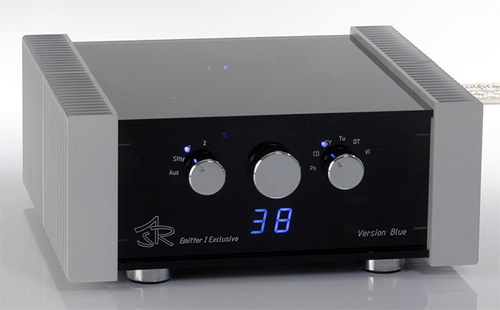
|
It's not my style to procrastinate; in fact, I consider it one of the minor sins. Likewise, I don't usually jump in headlong on first introduction, carried away by some novel excitement. (I've learned this tactic can be costly, both with people and audio. Never begin a product review before the thing is fully broken in, however long that may take. Don't even listen to it during this time, if you can manage that. Moderation, dear boy, is the key.) In this instance, with the ASR Emitter I Exclusive B integrated amp on my rack, my enthusiasm level was high, but I hesitated before putting pen to paper.
Fond Memories
We got off to a rocky start. For one thing, the Emitter didn't sound that much like the ASR Basis Exclusive Phono Stage, which I knew well, it having won me over during the course of the Phono Stage Hoedown I did back in January 2007. The Emitter started out in some ways even its antithesis.
The ASR Phono Stage struck me as a form of solid-state I'd never heard before. This box scored excellent grades in every category of the Audiophile Report Card. Simply put; it purged the host of artifacts we've come to accept as part and parcel of the classic "analog experience." But it was not the lean and mean machine that might imply. Certainly single-minded in its pursuit of high grades, it still managed to be very full-bodied and had good timbre. The ASR Phono Stage possessed most of what we value in tubes and solid-state, the best of both worlds. Listening to it spoiled me: the other phono stages in the survey didn't measure up.
Can solid-state sound lush?
So, now I have the ASR Emitter I Exclusive B integrated amp powered up. Can solid-state sound lush? I wouldn't have thought so. But, yes, here it is.
I have a fondness for 845 tube-based amps. I love how they move soloists, especially vocalists, a couple of steps forward in front of the mix, and then endow them with a special kind of inner life and palpable presence. The Emitter was showing off these very things. Its tonal balance was midrangy and warm, imaging was vague—this solid-state integrated was tubey in the classic sense of the word.
This was not right.
I attempted to do a cable shootout at this time, as an Argento Serenity Master Reference interconnect had come along with the Emitter. I compared the Argento to a TARA Labs "The Zero" and "The 0.8," Kharma Enigma and Kubala-Sosna Emotion interconnects. While it was easy to hear the extra dimension provided by The Zero—it's really in a class by itself—there wasn't that much difference among the others. The Emitter was injecting too much of its own personality.
The Ground Switch Option
Was I delirious? The fever persisted for four days after the importer installed the unit. I started to wonder about possible setup problems or internal part malfunctions. Then I remembered the Ground Switch located in back of the power supply unit. It was in the OFF or ground lifted, position. I powered down and flipped it ON, to engage the ground.
Note: the Ground Switch is there to help in case you experience a ground hum. If you do, flip the switch to the other position and hopefully the noise will go away. I didn't have to contend with noise in either switch position.
ZAP! There it was! In a flash, the adjective "lush" disappeared from my thoughts and all of the alluring attractions of the Basis Exclusive Phono Stage were there, just as I remembered them, and they were pushing my buttons.
Dynamically Virile
High on that list of attractions were outstanding dynamics. I went out and bought the SACD of the famous RCA Golden Age recording of Scheherazade with Reiner and the Chicago Symphony Orchestra (RCA SACD reissue 82876-66377-2) after HP touted it to the skies in The Absolute Sound magazine. He's right—the sound is fabulous, and I don't even have an SACD player. I'm listening to it on the hybrid layer. (While I don't care for SACD sound, I do prefer the hybrid layer of SACD discs to Redbook CDs played on 16/44 machines, but that's another story.)

Early in the first movement the low strings begin to growl, going into the first stage of a crescendo. The atmosphere in my sound room commences to stir sympathetically. Shortly thereafter the brass join in, precipitating further agitation in the room, such that you begin to feel the swells viscerally against your chest. Just when you think you've hit the dynamic ceiling and there's no place left to go, the low brass pile on. Now the very couch I'm sitting on has the tremors. The Scheherazade fortissimo seems to know no boundary. You viscerally participate, as f becomes ff, and then fff. Compound that with ASR's characteristic composure and sang froid during these sustained triple fff passages. Whew! It's quite extraordinary. It is the kind of thing that makes you gaze in glassy-eyed wonderment, and mumble "Huh? Did I just hear what I thought I did?" And to think it is coming off a battery pack… Well, at least some of it is.
In the second movement, Ray Still's haunting oboe solo is quite famous. The Emitter does not disappoint. Here it is then, a flowing line with some acoustic sheen or varnish applied to the instrument and little specular highlights, or sparkles, in the treble. Perhaps it is more beautiful than it should be. (My mbl Noble Line separates have a warmer tonal balance and are sweeter in the treble, but don't do this.) And perhaps the impressive low-end is more abundant and energetic than a strictly flat response might dictate. (Again, my mbl gear doesn't do this.) OK, but I'm sure not complaining. I rather like it—show me an audiophile who doesn't like powerful and tight bass. And it doesn't interfere with the treble—the irregular waveform of a triangle was wonderfully articulated, with all its minute jangle of parts.
The amp had no problem with my Kharma Exquisite-Midi speakers, a nominal 4 ohm load that can dip as low as 2.8. The rule of thumb here is the lower the impedance, the more difficult the load. I normally feed them 310-watts into four ohms (210 into eight ohms) from my mbl 8011 AM monoblocks—and I know this is short-changing them. So, I was concerned about pairing the Emitter's 290 watts into four ohms (160-watts into eight) with the 90dB sensitive speaker. Hah! The Emitter handled the Exquisite-Midi's with aplomb, showing no signs of stress. (However, the Emitter did indeed drive the recently arrived Kharma CRM 3.2.2 speakers, a much easier 6 ohm load not dipping below 4 and with the same 90dB sensitivity, to heightened levels of realism. See below for more on this.)
Emitter I Options: Basic, Exclusive, Exclusive B
The Emitter I comes in three guises. The Emitter I Basic ($10,900) has two chassis: a control unit and an external power supply. The power supply contains dual-mono sections to drive the dual-mono amps located in the control unit, and a separate section for the active line-stage, also located in the control unit. This box is massive (71 lbs), much heavier than the control unit (48 lbs). Output is 140-watts into 8 ohms. There's no battery with this version.
The Emitter I Exclusive ($14,900) looks the same as the Basic, with a control unit and external power supply, but has upgraded, premium parts inside. It yields 160-watts into 8 ohms and says "Emitter I Exclusive" on the faceplate.
At the top is the one I'm listening to, the Emitter I Exclusive B, or battery option ($17,900). This is the Exclusive version plus an additional chassis—a separate battery in another box about as big as the external power supply. In this configuration, the battery is dedicated to the active preamp, the power supply to the amplifiers. Output is also 160-watts into 8 ohms.
Dynamics Explained
Many factors come into play when calculating an amplifier's power. Upon inquiry, I was told a big part of the Emitter's buffo dynamics have to do with the products' reservoir of electrical capacitance. Look at these capacitance specs: the Basic has a total capacitance of 290,000 uF; the Exclusive has 570,000 uF; the Exclusive B has a staggering 890,000 uF, three times the Basic model. The huge capacitance number in the top-of-the-line Exclusive B version accounts for those groundbreaking dynamics I'm hearing. It also contributes to enhanced tonal purity. Take a look at the pictures showing the capacitors on the circuit board of the Exclusive B (below) and that of the Basic (below that).
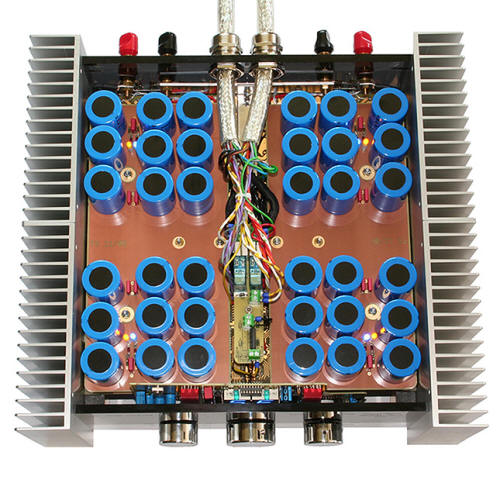
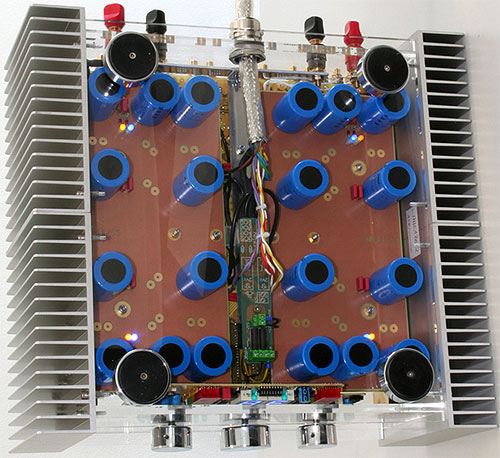
The Emitter's dynamics and low-end punch broke new ground at this price point. Transients fly around with a very natural leading edge. But one thing about that authoritative low-end: when combined with the unit's slightly dark tonal balance, it gives the musical line a low center-of-gravity. It is a bit heavy-set—it's not a light and bouncy type of sound. For an analogy from the dance world, the Emitter does not possess a classically trained ballet dancer's physique. It would look more akin to a muscular modern dancer, maybe one with a preference for the folk idiom or gymnastics. One works out at the barre, the other goes to the gym.
On second thought, while that is true, maybe I'm being too harsh. Listen to Le Quatuor Talich performing Mozart's Quatuor "Les Dissonances" (Calliope CAL 6256), or almost any of the Talich quartet recordings on the Calliope label—it doesn't matter which, the vast majority have earned Grand Prix du Disque awards.
On this recording, the sound is restrained, held to limited dynamic swings. The melody traverses small intervals, never veering far from middle C. You'll note splendid ensemble playing and marvelous articulation. Through the Emitter, these four players sound like a single organism. I'm sure their bow arms move in unison; perhaps they even inhale / exhale in synchronicity. Resolution is high (although not as high as the mbl gear). The details are there, embedded in the fabric of the soundstage, but they don't pop out at you: you have to consciously reach out and get them.
The Talich's soft, subtle, highly blended sound contrasts radically with that of my other favorite string quartet, the Emerson. The one evokes an old-world sensibility rarely encountered nowadays; the other is an exemplar of modern performance practice.
Such refinement is not for everybody. It won't impress a single one of your died-in-the-wool audiophile friends. No sir, but don't panic: your musician friends will get it, for this is what a first-rate string quartet in a good hall often sounds like. This disc is a discovery. Played back through the Emitter, I was rendered immobile. It was one of those moments when you're stopped in your tracks, frozen in place by the verisimilitude.
The "fooled-you" signature of this gear has the kind of stepless micro-dynamic shadings and smooth frequency transitions normally reserved for valves. They are almost the equal of the groundbreaking big swings. Timbral production backs off a bit from that high standard and is not excessively colorful, but is still top-notch for a solid-state device.
Of course, it didn't hurt that I had two lengths of TARA Labs "The Zero" cable in the run. This cable does things like no other. When you're dealing with acoustic instruments, it really comes closest to live. I'm convinced these require a different suitcase of strengths than that required for synthetic or amplified sounds. You don't need The Zero to play back a KORG synthesizer—it may even get in the way.
Noise Reduction
"You're not used to what you don't hear," I remember telling a friend. It seems illogical, but the quiet does take getting used to, just as I recall it did with the Basis Exclusive Phono Stage. Since I got my mbl Noble Line digital front end, I'm used to dead silence on those sections when nobody's playing. Now, on familiar LPs, I could swear that ticks and pops are quieter through the Emitter. The audible breakup on crescendos also seems lessened. Maybe it's the battery-powered preamp stage? Still, it wasn't the COMPLETE silence I remember with the Basis Exclusive. That 100% battery-operated component had a stillness approaching a dead zone, like being inside a laboratory. If you've grown accustomed to noise and artifact it can be a little spooky when they're totally gone.
There was no bleeding across source inputs. If I was playing an LP record I did not have to turn off the radio or CD. Channel separation was superb. There might be thunderous bass volleys firing off deep right, while woodwinds sweetly twittered a melody up front and left of center, both of these happening with complete independence. In use, there wasn't a single instance of malfunction or downtime over the course of the audition. I would venture that the engineering / design aspects of the Emitter are uncommonly well conceived and executed.
The unit has such an envious agglomeration of virtues, between the deafening silence, the purity of the signal, the grandly proportioned soundstage populated with large images, the abundant high grades across the audiophile scorecard, and all this conjoined with tube-like fleshy bodies and a deeply saturated, dark tonal balance, and satisfying timbral production… All of the telltale solid-state artifacts are gone. You'll never hear the adjective thin used to describe this gear.
And most of these characteristics are shared with my mbl Noble Line separates. This is what's so special about these two product lines. They commingle in one box the most desirable attributes of solid-state and tubes.
Yet, in spite of this overweighting of virtues, I often found myself on the outside, looking in. The Emitter had a coolness that somehow kept your emotions at a distance. It shared the reserve that I had noticed in the Basis Exclusive. Maybe that's because it's too clean and quiet—too neutral? It has what psychologists might describe as a flat affect. The musical line isn't quite the curvy waveform that it should be. This wasn't just me; this opinion came from a number of visitors.
Tweaks and Wires
The Emitter was very easy to voice and sounded great from the get-go. It replaces your preamp and amp, but it is still three big chassis. First there's the control unit, which contains the preamp and dual mono-amp sections. It went on a TAOC shelf. The other two boxes, the heavier power supply and the battery pack, first went on sand-filled constrained layer platforms that the importer provided. These didn't last. (I always find sand imparts spectacular weight and darkens the tonal balance, but also has an undesirable lossy, spongy quality.) Next I tried either maple or walnut wood flooring samples. These samples make great supports under the components' built-in feet and you can't beat the price—free. The different species of woods sound slightly different, making them excellent tuning tweaks. Ultimately the power units were placed on CORE Designs CLD walnut amp stands.
The battery pack is dedicated to the preamp. It can operate in two modes set by the control unit's selector switch. Set to "1" you're in energy saver mode: the "Energy" indicator light comes on and the battery is re-charging constantly, even as you're listening. Use this setting when the battery is low. (Battery strength is indicated by a row of diodes on its front panel.) Set the selector switch to "2" and charging stops. Now the preamp is running 100% off the battery's stored DC—it is functionally disconnected from the wall. This is the recommended setting for listening. When you are done for the night, set the selector switch to either Standby or Off to recharge the battery.
The battery pack is fitted with a standard 15 amp IEC input jack. Logically, if you operate in mode "2," the power cord to the battery shouldn't make a difference. On the other hand, the amp section is run off the external power supply, which takes AC direct from the wall—after-market PCs should be fertile ground for experimentation. Inconveniently, the power supply is fitted with a 20-amp power cable receptacle and I didn't have any spare PCs with this type of plug to test the hypothesis. I used the provided ASR power cords plugged into separate TARA Labs PM/2 passive AC conditioners. Note that the preamp doesn't really need a conditioner: the stored DC in the battery is the purest juice around.
Hold on. Near the end of the audition, a Kubala-Sosna Emotion PC with a 20-amp plug walked in (MSRP $1225). No more speculating: I can tell you it certainly does make a difference. The K-S cord enriched body and color, and fortified the bottom. Bass notes that I wasn't sure I heard were solid, tight and coherent to boot.
Pursuing this further, I continued adding Kubala-Sosna Emotion wire. This was when I had replaced the Kharma Exquisite-Midi speakers with the CRM 3.2.2. With each additional length I noted increased involvement. My reservations regarding the unit's aloofness receded. Then, at the point when the entire rig was dressed in Kubala-Sosna, something unpredictable happened. The rig morphed and became startlingly lifelike, albeit as a scaled-down reduction. Dudes who came by and heard this simply uttered, "Yeah. That's got it." The "it" they're referring to is very difficult to put your finger on, but I'll tell you, it isn't as simple as more Speed! Resolution! Dynamics! (the Three Tenets of Audiophilia). As best as I can fathom, the major ingredients of the ephemeral recipe call for accurate and complete timbral reproduction and a very elusive quality of dynamic openness. The timbre kicked in with the Kubala-Sosna wires. When you go shopping for wires for the Emitter, you want to favor the emotive side. (The Argento brand can be added to this list. The little that I heard placed it in that camp. More to come on this one down the road a bit.) The dynamic openness was a byproduct of the dream-team amp / speaker interface between the Emitter and the CRM 3.2.2.
Aside from the platforms they sat on and the wires, no tweaks were applied. The Emitter is in that class of gear that doesn't need its voice repaired. It will sound like I've described it out of the box, after sufficient burn-in. By all means, experiment with your arsenal of footers or isolation platforms. You may discover a synergy. I didn't hear anything that called out for repair, so I didn't feel the need to go exploring.
The battery and power supply connect to the control unit using humongous, heavy-duty industrial connectors, the like of which I've never seen in home use. Massive umbilicals connect these to the control unit. The umbilicals are detachable at the battery / power supply ends and fixed to the control unit. ASR tries to employ proven reliable industrial electrical fittings wherever possible and eschews common audiophile parts.
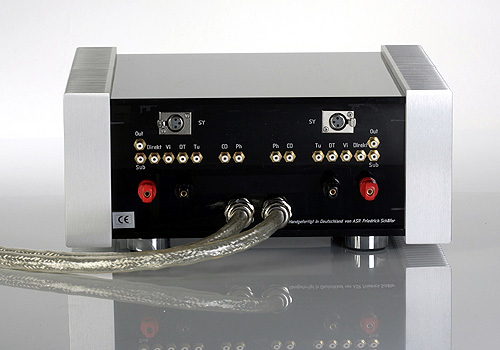
Fit-n-finish is well done. The ASR product line cosmetics were upgraded since I last saw them, maybe a year ago. The external power supply and battery pack now look presentable. Both have a smoked acrylic faceplate that matches the main unit. The remainder of the chassis is heavy-duty steel. Before, they were the sorts of ugly boxes you would try to hide out of sight.
The control unit has the smoked acrylic all over, except for the metal heat sinks on the sides. (These exist to meet EU standards; the unit's temperature is warm, nowhere close to requiring heat dissipation.)
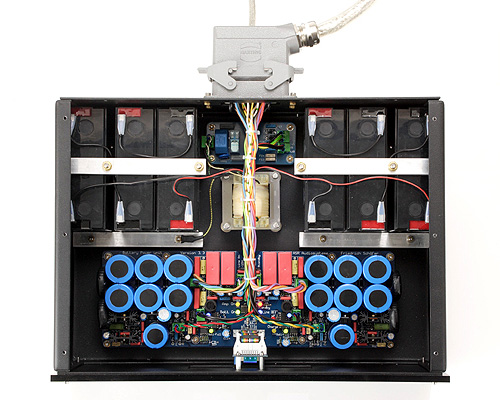
Inside all three chassis are colorful LEDs. While they make for a dandy Christmas-like display, their main function is diagnostic. Which ones are lit and their color give you a snapshot of the health of various circuits. This, and much more, is elaborated upon in the thoroughgoing Operating Manual, which runs to 20 pages.
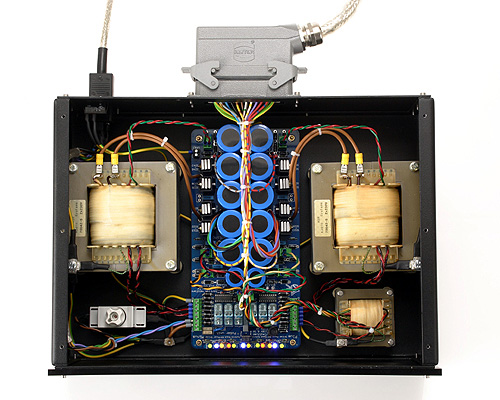
That manual also goes into the surprisingly wide range of adjustments possible via the remote control. How about: channel balance; front-panel brightness; contents of the front-panel display; even individual volume pots for source level matching. If you want, you can go inside the control unit, where you'll find high frequency compensation switches located on the mainboard to taper treble response. Also on the mainboard are defeatable DC protection circuits to prevent damage to your speakers from DC voltage.
My unit had lots of single-ended inputs and one set for XLR. One small gripe—I would like to see the RCA inputs spaced further apart. Connecting some of those fat-boy male jacks, like those on the TARA Zero or Kharma Enigma, produced strain on adjacent inputs.
Something you should know concerning the three selector knobs on the front panel of the control unit. They operate via relays. You will notice a short delay before your new selection is effected. Likewise, for the same reason, the remote is not the most responsive—there is often a delay and sometimes you have to click it twice. It may over-shoot and wind up in the next selection over from the one you wanted.
Conclusion
Finally, here's a component that steps up to the plate. The ASR Emitter I Exclusive B Integrated Amp is the first gear I've encountered at this price point that gives my mbl Noble Line separates competition.
In fact, the two product lines share many attributes: tonal balance is a little dark, modestly warm and deeply saturated; images are large and notably full-bodied; frequency response is smooth and linear. Few, if any, solid-state artifacts are present: there's no grain, no stridency, no edge. Overall, both lines are neutral and accurate.
I bet in a blind test you would be hard pressed to identify either as solid-state. These lines are exemplars of the next-gen of gear that is raising the bar for what's possible. With this gear, you can have it all: the estimable objective attractions of solid-state merged with the soft virtues of tubes. The Emitter takes these filament-like characteristics a step further than the mbl to the point where acoustic instruments exhibit an attractive patina, or varnish, and the treble has little sparkles. These contribute towards a slightly more beautiful sound.
Dynamics are, simply put, outstanding. Looking at its specs before it arrived, I was concerned about the amps' 160 watts into 8 ohms being adequate for the difficult load presented by my Kharma Exquisite-Midi speakers. Ha! The Emitter I Exclusive B didn't break a sweat and raised the bar for macro-dynamic range beyond my mbl 8011 AM mono-blocks.
And it handled micros with appropriate grace and subtlety. Quiet program material requiring minute pitch or volume shadings were nearly as expertly rendered as the big stuff.
Then, with the CRM 3.2.2 speakers and all K-S wiring, the system took off and was capable of reliable transport to the land of "it," as in "Yeah. That's got it," where suspension of disbelief is possible. This was a storybook combination.
I greatly enjoyed my time with the Emitter. In fact, if I didn't own the mbl Noble gear, I would seriously consider acquisition. The Emitter I Exclusive B's strengths place it among the top offerings at its price point—as long as you keep the Ground Switch in the ON position.
Note: I ran my impressions of the Ground Switch positions by the importer, who agreed in substance, if not in degree, attributing the difference to the quality of the AC at his installation in the backwoods of Illinois vs. that in my apartment in NYC.
It strikes me that maybe, just maybe, if Class D amps could be fixed—if the promise of Class D could be fully realized—they would sound like this. Marshall Nack
Manufacturer
ASR Audio Systeme
Friedrich Schäfer
web address:
www.asraudio.de
US Distributor
Half Note Audio
DeKalb, IL 60115
web address:
www.halfnoteaudio.com
